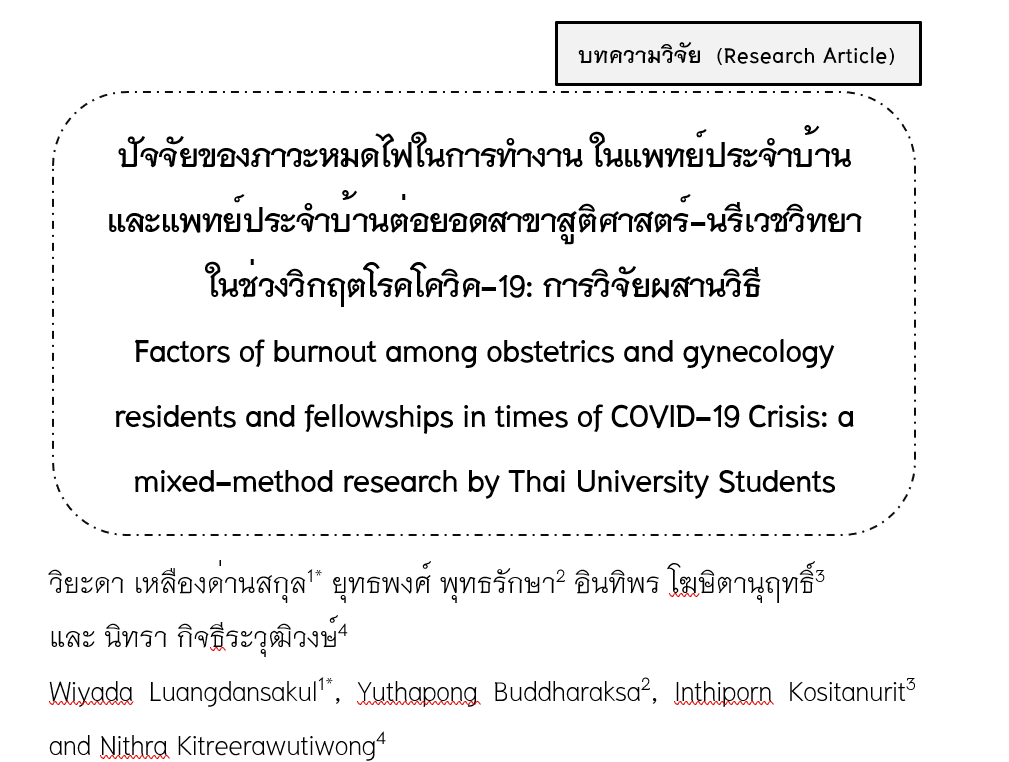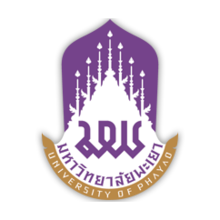ปัจจัยของภาวะหมดไฟในการทำงาน ในแพทย์ประจำบ้านและแพทย์ประจำบ้านต่อยอดสาขาสูติศาสตร์-นรีเวชวิทยาในช่วงวิกฤตโรคโควิค-19: การวิจัยผสานวิธี
คำสำคัญ:
ภาวะหมดไฟในการทำงาน, สาขาสูติศาสตร์-นรีเวชวิทยา, แพทย์ประจำบ้านและแพทย์ประจำบ้านต่อยอด, การศึกษาเชิงคุณภาพ, โควิค-19บทคัดย่อ
การวิจัยครั้งนี้มีวัตถุประสงค์เพื่อศึกษาภาวะหมดไฟ ปัจจัยที่เป็นสาเหตุและป้องกันการเกิดภาวะหมดไฟในการทำงานในช่วงการแพร่ระบาดของโรคโควิค-19 เป็นการวิจัยผสานวิธีแบบภาคตัดขวาง ในแพทย์ประจำบ้านและแพทย์ประจำบ้านต่อยอดสาขาสูติศาสตร์-นรีเวชวิทยา โรงพยาบาลภูมิพลอดุลยเดช ในระหว่างเดือนธันวาคม พ.ศ. 2564 ถึง เดือนมีนาคม พ.ศ. 2565 ผู้ให้ข้อมูลทำแบบทดสอบภาวะหมดไฟของ Maslach Burnout Inventory-Human Services Survey ฉบับภาษาไทยก่อนการสัมภาษณ์เชิงลึก แบบสอบถามกึ่งโครงสร้างได้มาจากการทบทวนวรรณกรรม การวิเคราะห์ข้อมูลใช้สถิติเชิงพรรณนาและความสอดคล้องเชิงเนื้อหา (content analysis).ผลการศึกษา ผู้ให้ข้อมูล ทั้งหมด 19 คน พบภาวะหมดไฟในการทำงาน ร้อยละ 63.2 ปัจจัยที่เป็นสาเหตุของภาวะหมดไฟในการทำงาน (1) ภาระงานและความสมดุลระหว่างการทำงานและชีวิต (2) ภาระการเรียน (3) การทำวิจัย (4) วัฒนธรรมองค์กร และ (5) ความกังวลในการติดเชื้อและการติดเชื้อโรคโควิค-19 ปัจจัยป้องกันการเกิดภาวะหมดไฟในการทำงาน (1) การสนับสนุนจากเพื่อน และครอบครัว (2) การสนับสนุนและการปกป้องจากอาจารย์ และ (3) ต้องการเวลาว่าง สรุป ความชุกของภาวะหมดไฟในการทำงาน ร้อยละ 63.2 ปัจจัยที่มีผลต่อภาวะหมดไฟในการทำงานสามารถทำนายถึงโอกาสเกิด และปัจจัยป้องกันเป็นข้อควรพิจารณาเพื่อพัฒนาระบบในการป้องกันภาวะหมดไฟในการทำงาน
เอกสารอ้างอิง
นครินทร์ ชุนงาม. (2563). สุขภาพจิตและภาวะหมดไฟในการทำงานของแพทย์ในโรงพยาบาลทั่วไป และโรงพยาบาลชุมชนจังหวัดนครราชสีมา. วารสารสุขภาพจิตแห่งประเทศไทย, 28(4), 348-359.
ประไพพิมพ์ สุธีวสินนนท์ และ ประสพชัย พสุนนท์. (2559). กลยุทธ์การเลือกตัวอย่างสำหรับการวิจัยเชิงคุณภาพ. วารสารปาริชาต มหาวิทยาลัยทักษิณ, 29(2), 32-48.
พจนานุกรมการสาธารณสุขไทย พ.ศ. 2561 ฉบับ 100 ปี การสาธารณสุขไทย. (2561). นนทบุรี: กระทรวงสาธารณสุข.
มนัสนันท์ หัตถศักดิ์ (2563). การศึกษาความสัมพันธ์ระหว่างบุคลิกภาพ รูปแบบการด าเนินชีวิต และแรงจูงใจใฝ่สัมฤทธิ์ของนักศึกษาในสถาบันอุดมศึกษา เขตกรุงเทพมหานคร. วารสารมนุษยศาสตร์และสังคมศาสตร์ มหาวิทยาลัยพะเยา, 8(2), 162-175.
ศิริพร แสงศรีจันทร์,พยาม การดี, กันยานันต๊ะแก้ว และรัตนา ทาสิทธิ์. (2556). ความสัมพันธ์ระหว่างปัจจัยด้านนิสิตกระบวนการเรียนการสอน ปัจจัยเกื้อหนุนกับความสุขของนิสิตพยาบาลมหาวิทยาลัยพะเยา. วารสารมนุษยศาสตร์และสังคมศาสตร์ มหาวิทยาลัยพะเยา, 1(2), 20-28.
Al-Ma’mari, N. a. O., Naimi, A. I., & Tulandi, T. (2016). Prevalence and predictors of burnout among obstetrics and gynecology residents in Canada. Gynecological Surgery, 13(4), 323-327. Form https://doi.org/10.1007/s10397-016-0955-3.
Alrawashdeh, H. M., Al-Tammemi, A. a. B., Alzawahreh, M. K., Al-Tamimi, A., Elkholy, M., Al Sarireh, F., Abusamak, M., Elehamer, N. M. K., Malkawi, A., Al-Dolat, W., Abu-Ismail, L., Al-Far, A., & Ghoul, I. (2021). Occupational burnout and job satisfaction among physicians in times of COVID-19 crisis: a convergent parallel mixed-method study. BMC Public Health, 21(1), 811. Form https://doi.org/10.1186/s12889-021-10897-4.
Aziz, H., James, T., Remulla, D., Sher, L., Genyk, Y., Sullivan, M. E., & Sheikh, M. R. (2021). Effect of COVID-19 on surgical training across the United States: a national survey of general surgery residents. J Surg Educ, 78(2), 431-439. Form https://doi.org/10.1016/j.jsurg.2020.07.037.
Becker, J. L., Milad, M. P., & Klock, S. C. (2006). Burnout, depression, and career satisfaction: cross-sectional study of obstetrics and gynecology residents. Am J Obstet Gynecol, 195(5), 1444-1449. Form https://doi.org/10.1016/j.ajog.2006.06.075.
Bourne, T., Shah, H., Falconieri, N., Timmerman, D., Lees, C., Wright, A., Lumsden, M. A., Regan, L., & Van Calster, B. (2019). Burnout, well-being and defensive medical practice among obstetricians and gynaecologists in the UK: cross-sectional survey study. BMJ Open, 9(11), e030968. Form https://doi.org/10.1136/bmjopen-2019-030968.
Charoentanyarak, A., Anothaisintawee, T., Kanhasing, R., & Poonpetcharat, P. (2020). Prevalence of burnout and associated factors among family medicine residency in Thailand. J Med Educ Curric Dev, 7, 2382120520944920. Form https://doi.org/10.1177/2382120520944920.
Gualano, M. R., Sinigaglia, T., Lo Moro, G., Rousset, S., Cremona, A., Bert, F., & Siliquini, R. (2021). The burden of burnout among healthcare professionals of intensive care units and emergency departments during the COVID-19 pandemic: a systematic review. International Journal of Environmental Research and Public Health, 18(15), 8172. Form https://www.mdpi.com/1660-4601/18/15/8172.
Halbesleben, J. R., & Rathert, C. (2008). Linking physician burnout and patient outcomes: exploring the dyadic relationship between physicians and patients. Health Care Manage Rev, 33(1), 29-39. Form https://doi.org/10.1097/01.Hmr.0000304493.87898.72.
Ironside, K., Becker, D., Chen, I., Daniyan, A., Kian, A., Saheba, N., & Hollander, R. (2019). Resident and faculty perspectives on prevention of resident burnout: a focus group study. Perm J, 23. Form https://doi.org/10.7812/tpp/18-185.
Iserson, K. V. (2018). Burnout syndrome: global medicine volunteering as a possible treatment strategy. J Emerg Med, 54(4), 516-521. Form https://doi.org/10.1016/j.jemermed.2017.12.062.
Khalafallah, A. M., Lam, S., Gami, A., Dornbos, D. L., Sivakumar, W., Johnson, J. N., & Mukherjee, D. (2020). A national survey on the impact of the COVID-19 pandemic upon burnout and career satisfaction among neurosurgery residents. J Clin Neurosci, 80, 137-142. Form https://doi.org/10.1016/j.jocn.2020.08.012.
Koutsimani, P., Montgomery, A., & Georganta, K. (2019). The relationship between burnout, depression, and anxiety: a systematic review and meta-analysis [systematic review]. Frontiers in Psychology, 10. Form https://doi.org/10.3389/fpsyg.2019.00284.
Looseley, A., Wainwright, E., Cook, T. M., Bell, V., Hoskins, S., O'Connor, M., Taylor, G., & Mouton, R. (2019). Stress, burnout, depression and work satisfaction among UK anaesthetic trainees; a quantitative analysis of the satisfaction and wellbeing in anaesthetic training study. Anaesthesia, 74(10), 1231-1239. Form https://doi.org/10.1111/anae.14681.
Mahoney, M. J. (1997). Psychotherapists' personal problems and self-care patterns. Professional Psychology: Research and Practice, 28, 14-16.
Maslach, C., & Leiter, M. P. (1997). Maslach Burnout Inventory. Maslach Burnout Inventory Manual, 191-218.
Maslach C, J. S., Leiter M. . (2018). Maslach burnout inventory. Mind Garden, Inc.
Melamed, S., Shirom, A., Toker, S., Berliner, S., & Shapira, I. (2006). Burnout and risk of cardiovascular disease: evidence, possible causal paths, and promising research directions. Psychol Bull, 132(3), 327-353. Form https://doi.org/10.1037/0033-2909.132.3.327.
Morgan, H. K., Winkel, A. F., Nguyen, A. T., Carson, S., Ogburn, T., & Woodland, M. B. (2019). Obstetrics and gynecology residents' perspectives on wellness: findings from a national survey. Obstet Gynecol, 133(3), 552-557. Form https://doi.org/10.1097/aog.0000000000003103.
Rigby, F. B., Bynum, B., Santen, S. A., Anabazhagan, A., & Karjane, N. (2019). Burnout in OB/GYN students and residents. Clin Obstet Gynecol, 62(3), 413-431. Form https://doi.org/10.1097/grf.0000000000000467.
Rothenberger, D. A. (2017). Physician burnout and well-being: a systematic review and framework for action. Diseases of the Colon & Rectum, 60(6), 567-576. Form https://doi.org/10.1097/dcr.0000000000000844.
Rutherford, K., & Oda, J. (2014). Family medicine residency training and burnout: a qualitative study. Canadian medical education journal, 5(1), e13-e23. Form https://pubmed.ncbi.nlm.nih.gov/26451218.
Thomas, N. K. (2004). Resident burnout. Jama, 292(23), 2880-2889. Form https://doi.org/10.1001/jama.292.23.2880.
Treluyer, L., & Tourneux, P. (2021). Burnout among paediatric residents during the COVID-19 outbreak in France. European Journal of Pediatrics, 180(2), 627-633. Form https://doi.org/10.1007/s00431-020-03907-x.
Walsh, G., Hayes, B., Freeney, Y., & McArdle, S. (2019). Doctor, how can we help you? Qualitative interview study to identify key interventions to target burnout in hospital doctors. BMJ Open, 9(9), e030209. Form https://doi.org/10.1136/bmjopen-2019-030209.
White, E. M., Wetle, T. F., Reddy, A., & Baier, R. R. (2021). Front-line nursing home staff experiences during the COVID-19 pandemic. J Am Med Dir Assoc, 22(1), 199-203. Form https://doi.org/10.1016/j.jamda.2020.11.022.
Winkel, A. F., Honart, A. W., Robinson, A., Jones, A. A., & Squires, A. (2018). Thriving in scrubs: a qualitative study of resident resilience. Reprod Health, 15(1), 53. Form https://doi.org/10.1186/s12978-018-0489-4.

ดาวน์โหลด
เผยแพร่แล้ว
รูปแบบการอ้างอิง
ฉบับ
ประเภทบทความ
สัญญาอนุญาต
ลิขสิทธิ์ (c) 2022 มหาวิทยาลัยพะเยา

อนุญาตภายใต้เงื่อนไข Creative Commons Attribution-NonCommercial-NoDerivatives 4.0 International License.
ผู้นิพนธ์ต้องรับผิดชอบข้อความในบทนิพนธ์ของตน มหาวิทยาลัยพะเยาไม่จำเป็นต้องเห็นด้วยกับบทความที่ตีพิมพ์เสมอไป ผู้สนใจสามารถคัดลอก และนำไปใช้ได้ แต่จะต้องขออนุมัติเจ้าของ และได้รับการอนุมัติเป็นลายลักษณ์อักษรก่อน พร้อมกับมีการอ้างอิงและกล่าวคำขอบคุณให้ถูกต้องด้วย
The authors are themselves responsible for their contents. Signed articles may not always reflect the opinion of University of Phayao. The articles can be reproduced and reprinted, provided that permission is given by the authors and acknowledgement must be given.







